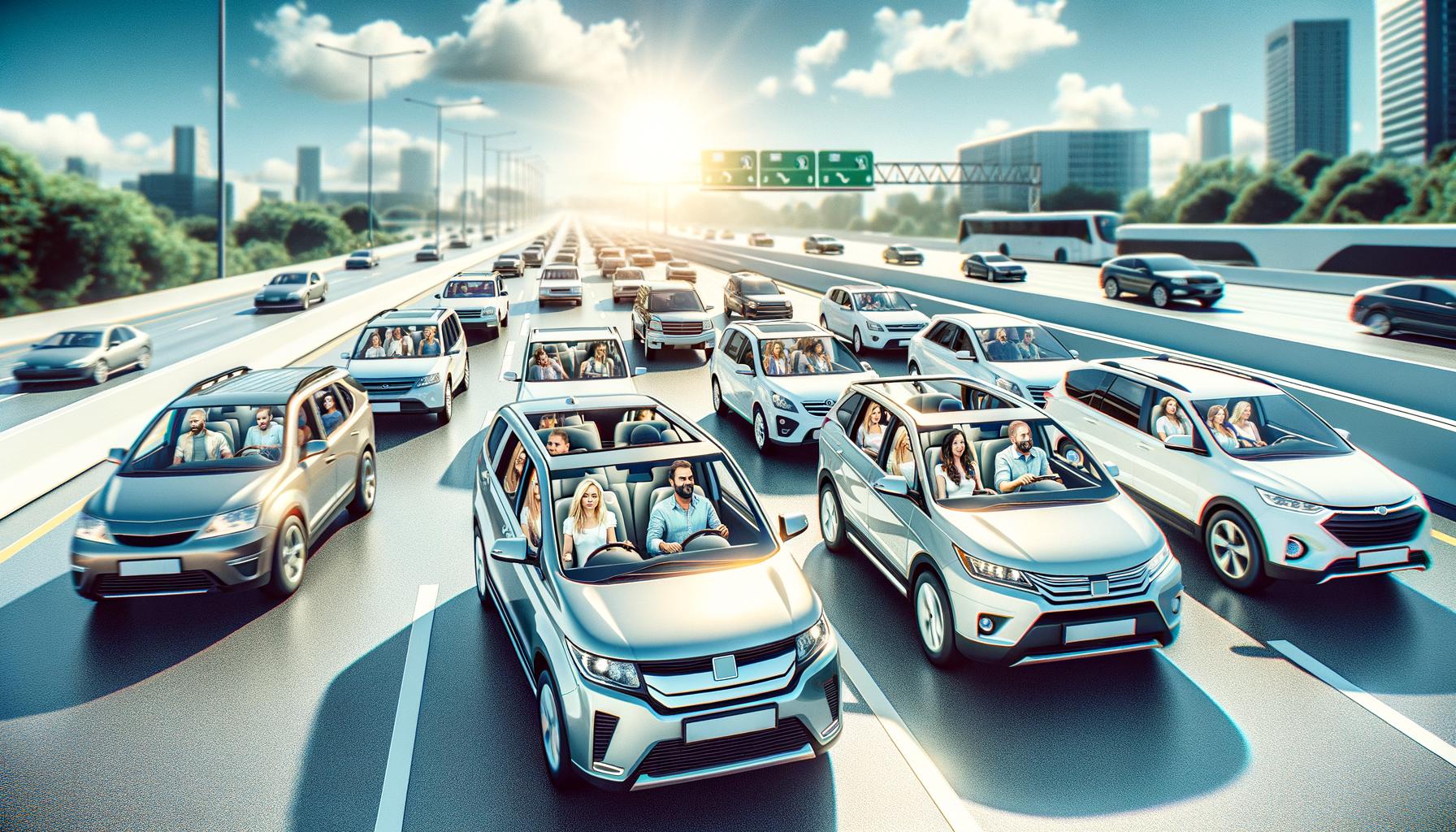Navigating the rules of carpool lanes can be confusing for many drivers. At The Wiser Driver Driving School, we often field questions about these special highway features.
Carpool lane rules are designed to promote ride-sharing and reduce traffic congestion. Understanding these regulations is essential for all drivers, whether you’re a frequent carpooler or not.
What Are Carpool Lanes?
Carpool lanes, also known as High Occupancy Vehicle (HOV) lanes, are special highway lanes designed to promote ride-sharing and reduce traffic congestion. These lanes are typically reserved for vehicles carrying multiple occupants, usually two or more people including the driver.
Types of Carpool Lanes
There are several types of carpool lanes you might encounter:
-
Traditional HOV Lanes: These are the most common type, restricted to vehicles with multiple occupants during peak hours.
-
High Occupancy Toll (HOT) Lanes: These allow single-occupant vehicles to use the lane by paying a toll, while carpools can use them for free or at a reduced rate.
-
Express Lanes: Similar to HOT lanes, these offer a faster travel option for carpools and toll-paying solo drivers.
According to the Federal Highway Administration, as of 2024, there are 105 HOV lanes in 19 states and 37 HOT facilities in 10 states across the U.S.
Benefits of Carpool Lanes
Carpool lanes offer significant advantages for both individual drivers and the broader community:
-
Time Savings: California’s HOV lanes carry 2,518 persons per hour during peak hours, substantially more people than a congested mixed-flow lane.
-
Reduced Congestion: By encouraging ride-sharing, carpool lanes help decrease the number of vehicles on the road during peak hours. A study by the Texas A&M Transportation Institute found that HOV lanes can move up to 7,000 people per hour, compared to 2,000 in a regular lane.
-
Environmental Impact: Fewer cars on the road means reduced emissions. The U.S. Environmental Protection Agency estimates that carpooling can reduce carbon dioxide emissions by about 15% per year for a typical commuter.
Using Carpool Lanes Effectively
To make the most of carpool lanes:
-
Plan Your Route: Identify carpool lanes along your regular commute and consider adjusting your route to take advantage of them.
-
Find Carpool Partners: Use local ridesharing apps or workplace carpool programs to connect with potential carpool partners.
-
Know the Rules: Carpool lane regulations can vary by location. Always check local signage for specific occupancy requirements and hours of operation.

Remember, improper use of carpool lanes can result in hefty fines. In California, for example, violations can cost up to $490 for a first offense. Stay informed and use these lanes responsibly to enjoy their benefits while contributing to smoother traffic flow for everyone on the road.
How Do Carpool Lane Rules Work?
Carpool lane rules can vary significantly depending on your location, but understanding the basics will help you navigate these lanes safely and legally. Let’s break down the key aspects of carpool lane regulations.
Occupancy Requirements
The core principle of carpool lanes is to encourage ride-sharing. Most carpool lanes require a minimum of two occupants per vehicle, including the driver. However, some high-traffic areas may require three or more occupants. For example, vehicles with two occupants pay a toll during peak hours (5am-9am; 4pm-7pm) but will have toll-free access during off-peak hours on the I-10 and I-110 ExpressLanes in Los Angeles.

It’s crucial to note that children and infants count as passengers. However, pets do not count towards the occupancy requirement. Always check local signage for specific occupancy rules, as they can change based on traffic patterns and local policies.
Vehicle Types and Restrictions
While carpool lanes primarily cater to passenger vehicles, other types of transportation may also be permitted. Motorcycles are generally allowed in carpool lanes across the United States, regardless of the number of riders. This policy is based on safety considerations and the minimal impact motorcycles have on traffic flow.
Public transit buses are typically permitted in carpool lanes, aligning with the goal of moving more people in fewer vehicles. However, large trucks and vehicles towing trailers are often prohibited from using these lanes due to safety concerns and their potential to slow traffic.
In some states, certain low-emission or electric vehicles can use carpool lanes with a single occupant. For instance, California’s Clean Air Vehicle (CAV) program allows qualifying vehicles to use HOV lanes with a special decal. However, these programs often have expiration dates or limits to prevent overcrowding of the lanes.
Operating Hours and Time Restrictions
Carpool lane operating hours can vary widely. Some lanes operate 24/7, while others are only active during peak commute hours. For example, many carpool lanes in the Seattle area are operational from 5 AM to 7 PM on weekdays.
Part-time HOV lanes, common in areas like Northern Virginia, function as regular lanes during off-peak hours. This flexibility allows for better traffic management throughout the day. Always pay attention to electronic signs that indicate when carpool restrictions are in effect.
At The Wiser Driver Driving School, we emphasize the importance of staying alert to changing traffic patterns and signage, especially when using carpool lanes with variable operating hours.
Entry and Exit Points
Proper use of entry and exit points is crucial for carpool lane safety and efficiency. In many areas, solid double white or yellow lines indicate where it’s illegal to enter or exit the carpool lane. These restrictions are designed to maintain smooth traffic flow and prevent accidents.
Legal entry and exit points are typically marked by dashed lines. Some carpool lanes have designated entry and exit zones, while others allow more frequent access points. In areas like Orange County, California, continuous access carpool lanes are becoming more common, allowing drivers to enter and exit at any point where there’s a dashed line.
Understanding and following these rules not only keeps you legal but also contributes to the overall effectiveness of the carpool lane system. Remember, improper use of these lanes can result in significant fines and penalties.
What Happens If You Break Carpool Lane Rules?
Carpool lane violations are taken seriously by law enforcement agencies across the United States. The penalties for misusing these lanes can be steep, and enforcement methods are becoming increasingly sophisticated. Let’s explore the consequences of breaking carpool lane rules and how these regulations are enforced.
Fines and Penalties
The cost of violating carpool lane rules varies by state and can be substantial. In California, fines generally range from $250 to over $500, depending on the jurisdiction, with additional court fees and penalties possible. In Washington state, the base fine for an HOV violation is $186, but this can escalate quickly with additional infractions.

Some states have implemented escalating fine structures to deter repeat offenders. For instance, in Virginia, a first offense might result in a $125 fine, but subsequent violations within five years can lead to fines of up to $1,000 and potential license suspension.
It’s not just about the monetary cost. In some jurisdictions, carpool lane violations can also add points to your driving record. This can lead to increased insurance premiums and, in severe cases, license suspension.
Enforcement Techniques
Law enforcement agencies use various methods to catch carpool lane violators. Traditional techniques involve officers visually monitoring lanes and pulling over suspected violators. However, more advanced technologies are increasingly being employed.
Automated camera systems are becoming common in many areas. These high-resolution cameras can capture images of vehicle occupants, allowing for more efficient enforcement. For example, San Francisco’s Bay Area has implemented a pilot program using vehicle occupancy detection technology as part of improvements to the Sterling Street/Bryant Street on-ramp.
Some regions are experimenting with infrared cameras that can detect the heat signatures of vehicle occupants. This technology is particularly useful for nighttime enforcement when visual identification is more challenging.
Common Misconceptions
There are several misconceptions about carpool lane use that often lead to violations. One prevalent myth is that pregnant women count as two occupants. This is not true in any U.S. state – an unborn child does not count towards the occupancy requirement.
Another common misunderstanding involves the use of mannequins or inflatable dolls to simulate passengers. Not only is this illegal, but it’s also easily detectable by experienced officers and modern enforcement technologies.
Some drivers believe that they can quickly enter and exit carpool lanes to bypass traffic. However, crossing solid lines to enter or exit these lanes is illegal and dangerous. At The Wiser Driver Driving School, we stress the importance of using designated entry and exit points to ensure safety and compliance.
Lastly, there’s a misconception that carpool lanes are underutilized and therefore it’s acceptable to use them improperly during heavy traffic. In reality, studies show that HOV lanes move significantly more people per hour than general-purpose lanes, even if they appear less crowded.
Understanding these rules and dispelling common myths is crucial for all drivers. The penalties for violations are designed to maintain the integrity and effectiveness of the carpool lane system. By following the rules, you not only avoid fines but also contribute to reduced traffic congestion and improved air quality in your community.
Final Thoughts
Carpool lane rules play a vital role in managing traffic flow and reducing congestion on our highways. By promoting ride-sharing and efficient use of road space, these lanes benefit both individual commuters and the broader community. Understanding and adhering to carpool lane regulations is not just about avoiding fines; it’s about contributing to a smoother, more sustainable transportation system.

Remember that carpool lane rules can vary by location and time of day. Always check local signage for specific occupancy requirements, operating hours, and entry/exit points. Proper use of these lanes can lead to significant time savings, reduced stress, and a smaller environmental footprint.
At The Wiser Driver Driving School, we emphasize the importance of responsible driving, including the correct use of carpool lanes. Our comprehensive programs are designed to help drivers of all ages navigate the complexities of modern traffic systems safely and confidently. From state-required courses to personalized driving lessons, we’re committed to creating skilled, knowledgeable drivers who contribute positively to road safety.
We encourage all drivers to take advantage of carpool lanes when appropriate. By carpooling, you’re not only saving time and money but also doing your part to alleviate traffic congestion and reduce emissions. If you’re looking to enhance your driving skills and knowledge, consider exploring our range of driving courses. With The Wiser Driver, you’ll gain the confidence and expertise to navigate any road situation, including the proper use of carpool lanes.
By understanding and respecting carpool lane rules, we can all contribute to a more efficient, safer, and environmentally friendly transportation system. Let’s drive wisely and share the road responsibly.



